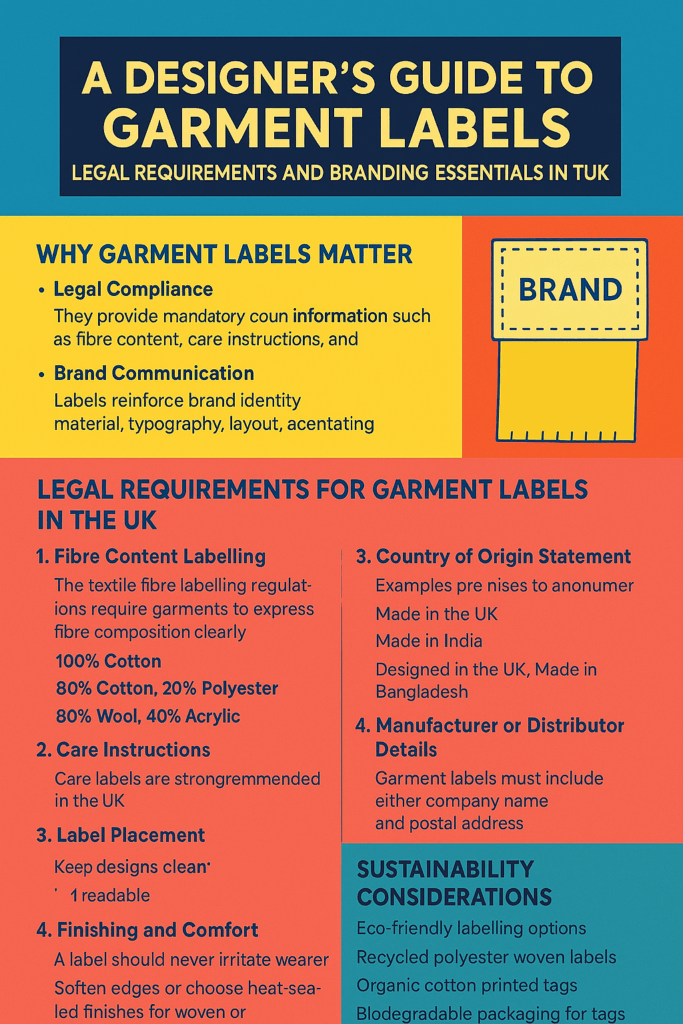When launching a clothing line in the UK, the small fabric tag sewn into your garments is as critical as the main design. Garment labels are a dual-purpose necessity: they are a cornerstone of your brand identity and a non-negotiable legal requirement under UK textile regulations.
Ignoring correct labeling can lead to product returns, customs issues, hefty penalties, and removal from major retail platforms. This definitive guide breaks down the mandatory legal requirements and the branding strategies you need to master to ensure your clothing is compliant, professional, and retail-ready for the UK market in 2024.
Why Garment Labels Are Non-Negotiable for UK Brands
Garment labels serve two foundational roles that directly impact your brand’s bottom line and legal standing:
- Legal Compliance & Consumer Protection: UK law mandates the inclusion of specific information, like fibre content, to ensure transparency. This protects the consumer by providing accurate product data and protects the brand from legal disputes related to misrepresentation.
- Brand & Value Communication: Labels are a tactile touchpoint. The material choice (e.g., woven vs. printed), the logo execution, and the placement all contribute to the garment’s perceived quality and reinforce brand trust.
The UK Legal Requirements Checklist for Garment Labels
UK regulations governing textile products require several pieces of information to be permanently fixed to the garment.
1. Mandatory: Fibre Content Labelling
The most critical legal requirement in the UK is the declaration of fibre composition, which falls under the Textile Products (Labelling and Fibre Composition) Regulations.
- Requirement: The label must clearly list all fibres in descending order by percentage of the textile weight.
- Examples:
100% Cotton,80% Wool, 20% Nylon.
- Examples:
- Terminology: Only standard, recognised fibre names (e.g., Polyester, Cotton, Elastane) are acceptable. Do not use trade names or fancy descriptors as substitutes.
- The “Pure” Rule: The word ‘Pure’ or ‘100%’ can only be used if the product is composed exclusively of that single fibre.
2. Manufacturer or Distributor Identification (Traceability)
For accountability, customers must be able to trace the product back to the brand or company responsible for placing it on the UK market.
- Requirement: Include either the company name and a UK contact address, OR a fully traceable business name (e.g., your official website and brand name). This strengthens consumer trust and is crucial for product recalls or quality disputes.
3. Country of Origin Statement (Required to Avoid Misleading)
While not universally mandatory on every single UK garment, stating the country of origin becomes a legal requirement if omitting it would mislead the consumer.
- Best Practice: Always include the truthful country of manufacture.
- Examples:
Made in the UK,Made in France.
- Examples:
- Avoid Misleading Claims: If a garment is designed in London but manufactured overseas, clearly state:
Designed in the UK, Made in Vietnam. Fraudulent or misleading origin labelling is strictly illegal.
4. Care Instructions (Highly Recommended, but not Mandatory)
Care labels are not a legal requirement in the UK, but they are an absolute industry standard and highly recommended.
- Liability Risk: Without clear care instructions, the brand may be held liable for damage caused during a reasonable cleaning process.
- Best Practice: Use the internationally recognised GINETEX care symbols (washing, bleaching, drying, ironing, professional care) as they are universally understood and minimise space. Note: Brands must often acquire a license to use these symbols in the UK.
Branding Essentials: Elevating Your Clothing Labels
Your label is a critical element of your visual identity. It impacts the perceived price and quality of the garment.
| Branding Element | Designer Strategy | Impact on Perception |
| Label Material | Choose a material that aligns with your brand values and price point. | Woven Labels (Damask): Communicate luxury and durability. Printed Satin Labels: Offer a softer, low-irritation feel for delicates/lingerie. Organic Cotton Tags: Signal sustainability and natural sourcing. |
| Logo & Typography | Keep the main logo label clean. The logo must be legible when woven or printed at a small scale. | Clarity: Reduces visual clutter. The small size makes legibility paramount. Consistency: Must match all other brand touchpoints (swing tags, packaging). |
| Placement & Comfort | Use Centre-fold or End-fold woven labels at the neck for premium branding. Care labels should be placed in the side seam where they can be easily cut off if needed. | Comfort: Non-irritating labels are essential for customer satisfaction. Perceived Quality: Consistent, neat placement across all styles demonstrates professionalism. |
| Sustainability | Integrate eco-friendly options, such as recycled polyester yarn for woven labels or GOTS-certified organic cotton. | Conscious Branding: Appeals to the growing segment of UK consumers prioritising sustainable fashion and strengthens your brand narrative. |
Common Garment Label Mistakes to Avoid
- Inconsistent Fibre Content: Always verify the fibre composition with your fabric supplier and ensure it matches the label exactly.
- Using ‘Silky’ or ‘Wool-like’: Avoid descriptive terms; only use official textile fibre names.
- Missing Contact Details: Failing to include your company name or address compromises traceability and violates legal requirements.
- Poor Quality Printing: Labels that fade, bleed, or tear easily after a few washes damage customer trust and lead to complaints.
- Irritating Materials: A scratchy neck label leads to the customer cutting it out—and losing your brand information. Prioritise soft, durable materials.
By adhering to the strict UK Textile Labelling Regulations while strategically using your label to reinforce your brand narrative, you ensure your clothing line is legally compliant and perfectly positioned for success in the competitive UK retail landscape.



